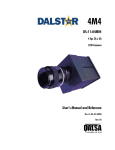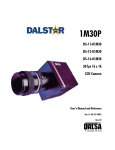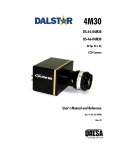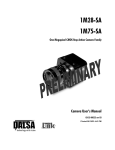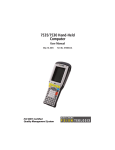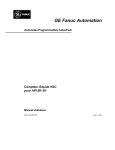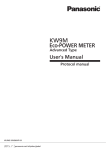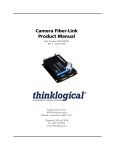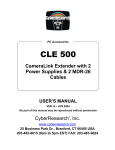Download Dalstar DS-1x-06M03 User`s manual
Transcript
6M3P DS-1x-06M03 2.75 fps 3k x 2k CCD Camera User’s Manual and Reference Doc #: 03-32-10005 Rev: 02 6M3P Camera User’s Manual 2 © 2002 DALSA. All information provided in this manual is believed to be accurate and reliable. No responsibility is assumed by DALSA for its use. DALSA reserves the right to make changes to this information without notice. Reproduction of this manual in whole or in part, by any means, is prohibited without prior permission having been obtained from DALSA. About DALSA DALSA is an international high performance semiconductor and electronics company that designs, develops, manufactures, and markets digital imaging products and solutions, in addition to providing wafer foundry services. DALSA’s core competencies are in specialized integrated circuit and electronics technology, and highly engineered semiconductor wafer processing. Products include image sensor components; electronic digital cameras; and semiconductor wafer foundry services for use in MEMS, power semiconductors, image sensors and mixed signal CMOS chips. DALSA is a public company listed on the Toronto Stock Exchange under the symbol “DSA”. Based in Waterloo, On. Canada, the company has operations in Bromont, PQ; Colorado Springs, CO; Tucson, AZ; Eindhoven, NL; Munich, Germany and Tokyo, Japan. All DALSA products are manufactured using the latest state-of-the-art equipment to ensure product reliability. DALSTAR refers to all DALSA area scan products. For further information not included in this manual, or for information on DALSA’s extensive line of image sensing products, please contact us. DALSA Sales Offices Waterloo 605 McMurray Rd Waterloo, ON N2V 2E9 Canada Tel: 519 886 6000 Fax: 519 886 8023 www.dalsa.com [email protected] DALSA Waterloo Europe Asia Pacific 605 McMurray Rd Waterloo, ON N2V 2E9 Canada Tel: 519 886 6000 Fax: 519 886 8023 www.dalsa.com [email protected] Breslauer Str. 34 D-82194 Gröbenzell (Munich) Germany Tel: +49 - 8142 – 46770 Fax: +49 - 8142 – 467746 www.dalsa.com [email protected] Space G1 Building, 4F 2-40-2 Ikebukuro Toshima-ku, Tokyo 171-0014 Japan +81 3 5960 6353 (phone) +81 3 5960 6354 (fax) www.dalsa.com [email protected] DALSA Worldwide Operations Colorado Tucson Europe Springs 5055 Corporate Plaza Drive Colorado Springs, CO 80919 USA Tel: 719 599 7700 Fax: 719 599 7775 www.dalsa.com [email protected] 3450 S. Broadmont Dr. Suite #128 Tucson, AZ 857135245 USA Tel: 520 791 7700 Fax: 520 791 7766 http://lifesciences.dals a.com [email protected] Breslauer Str. 34 D-82194 Gröbenzell (Munich) Germany Tel: +49 - 8142 – 46770 Fax: +49 - 8142 – 467746 www.dalsa.com [email protected] Asia Pacific Space G1 Building, 4F 2-40-2 Ikebukuro Toshima-ku, Tokyo 171-0014 Japan +81 3 5960 6353 (phone) +81 3 5960 6354 (fax) www.dalsa.com [email protected] 03-32-10005-02 6M3P Camera User’s Manual 3 &RQWHQWV Introduction to the 6M3P Camera ____________________________________________ 5 1.1 Camera Highlights ...................................................................................................................................................... 5 1.2 Image Sensor .............................................................................................................................................................. 6 1.3 Camera Performance Specifications............................................................................................................................ 8 Camera Hardware Interface ________________________________________________ 10 2.1 Installation Overview .................................................................................................................................................. 10 2.2 Input/Output ............................................................................................................................................................... 10 2.3 LED Status Indicators .................................................................................................................................................. 11 2.4 Power Input................................................................................................................................................................. 12 2.5 Data Output ................................................................................................................................................................ 13 2.6 Serial Communication................................................................................................................................................. 14 2.7 TTL Trigger Input and Output..................................................................................................................................... 16 2.8 Integration Time ......................................................................................................................................................... 16 2.9 Timing......................................................................................................................................................................... 17 Camera Operation ______________________________________________________ 21 3.1 How to Control the Camera......................................................................................................................................... 21 &Rntrol Register Reference.......................................................................................................................................... 22 3.3 Reading the Camera Type........................................................................................................................................... 23 3.4 Reading the Firmware Revision.................................................................................................................................. 23 3.5 Resetting the Camera.................................................................................................................................................. 23 3.6 Adjusting Gain ............................................................................................................................................................ 24 3.7 Adjusting User Offset .................................................................................................................................................. 24 3.8 Controlling Binning..................................................................................................................................................... 25 3.9 Triggering, Integration, and Frame Rate Overview ................................................................................................... 26 3.10 Controlling Integration (Shutter Time)..................................................................................................................... 27 3.11 Controlling Frame Rate............................................................................................................................................. 30 Optical and Mechanical Considerations ________________________________________ 32 4.1 Mechanical Interface ................................................................................................................................................... 32 4.2 Mechanical Tolerances ................................................................................................................................................ 33 4.3 Mounting the Camera ................................................................................................................................................. 33 Cleaning and Maintenance ________________________________________________ 34 5.1 Cleaning...................................................................................................................................................................... 34 DALSA 03-32-10005-02 6M3P Camera User’s Manual 4 5.2 Maintenance................................................................................................................................................................ 36 Troubleshooting ________________________________________________________ 37 Warranty _____________________________________________________________ 38 7.1 Limited One-Year Warranty........................................................................................................................................ 38 Index _______________________________________________________________ 39 DALSA 03-32-10005-02 6M3P Camera User’s Manual 5 1 ,QWURGXFWLRQWRWKH03 &DPHUD 1.1 Camera Highlights Features • 3072 x 2048 resolution, Full-frame CCD architecture. • 2.75 fps one output at full resolution, 20 MHz data rate • True 12-bit digitization • High sensitivity with low dark current • Progressive scan readout • Asynchronous image capture, externally triggerable to within 200 ns. • Selectable binning up to 8 x 8 • Programmable operation via RS232, including gain (1x and 4x) , offset (-2047 to + 2048), frame rate, binning, and triggering. • 100% fill factor Description The 6M3P digital camera provides high-sensitivity 12-bit images with 3k x 2k spatial resolution at up to 2.75 frames per second (fps). The 6M3P is a Full Frame CCD camera using a progressive scan CCD to simultaneously achieve outstanding resolution and gray scale characteristics. A square pixel format and high fill factor provide superior, quantifiable image quality even at low light levels. Applications The 6M3P is an outstanding performer in fast, very high resolution applications. True 12 bit performance provides up to 4096 distinct gray levels—perfect for applications with large interscene light variations. The low-noise, digitized video signal also makes the DALSA 03-32-10005-02 6M3P Camera User’s Manual 6 camera an excellent choice where low contrast images must be captured in challenging applications. 1.2 Image Sensor Figure 1. Image Sensor Block Diagram EODFNOLQHV ,PDJH$UHD DFWLYH OLQHV OLQHV SL[HOV SL[HOV DFWLYH SL[HOV 2XWSXW$PSOLILHU FHOOV 2XWSXW5HJLVWHU EODFNOLQHV FHOOV Table 1. Sensor Structure Sensor characteristics DALSA Optical size 36.864mm (H)x24.576 mm (V) Chip size 39.148 mm (H)x26.508 mm (V) Pixel size 12µm x 12µm Active pixels 3072 (H) x 2048 (V) Total number of pixels 3120 (H) x 2060 (V) Optical black pixels Left: 20 Right: 20 Timing pixels Left: 4 Right: 4 Dummy register cells Left: 7 Right: 7 Optical black lines Bottom: 6 Top: 6 03-32-10005-02 6M3P Camera User’s Manual 7 Table 2. Sensor Cosmetic Specifications Type Allowable Blemishes Columns 1 Clusters 6 Pixels 36 Definition of blemishes Pixel defect • Pixel whose signal, at nominal light (illumination at 50% of the linear range), deviates more than r30% from its neighboring pixels. • Pixel whose signal, in dark, deviates more than 6mV from its neighboring pixels (about 1% of nominal light). Cluster defect • A grouping of pixel defects where within a sub area of 3*3 pixels there are at most 5 present. Column or row defect • A column or row which has more than 12 pixel defects. • Column defects must be horizontally separated by 3 columns. • Row defects are not allowed. Test conditions DALSA • Temperature : 35°C • Integration Time : 10 ms 03-32-10005-02 6M3P Camera User’s Manual 8 1.3 Camera Performance Specifications Table 3: 6M3P Camera Performance Specifications Physical Characteristics Units Resolution HxV pixels 3072x2048 Pixel Size µm 12x12 Pixel Fill Factor % 100 Size mm 95x95x142 Mass kg 0.85 Power Dissipation W < 17 Lens Mount Aperture F , M72, or M72 color mount mm Regulatory Compliance Pending Shock Immunity Pending Vibration Immunity Pending Operating Ranges Units Min. Max. Frame Rate fps 2.75 12.5 Data Rate MHz 2.5 20 Data Format LVDS/R S422 Operating Temp °C Responsivity DN/(nJ/ 2 cm ) +15 Input Voltage V +14.925 +15.075 +5 Input Voltage V +4.975 +5.025 -5 Input Voltage V - 4.975 - 5.025 1x 4x Nominal Gain Range 12 bit 10 45 19@540nm Calibration Conditions Units Setting Min. Max. Data Rate MHz 20 20 20 Frame Rate Hz 2.75 +15 Input Voltage V +15 +14.925 +15.075 +5 Input Voltage V +5 +4.975 +5.025 -5 Input Voltage V - 5 - 4.975 - 5.025 Ambient Temperature °C 25 Binning Gain DALSA 36.9x24.6 1x1 X 1 03-32-10005-02 6M3P Camera User’s Manual DALSA 9 Min. Typical Electro-Optical Specifications Units Dynamic Range dB Pixel Response NonUniformity %rms 2 System Noise DN(rms) 0.9 Max. 70 03-32-10005-02 6M3P Camera User’s Manual 10 2 &DPHUD+DUGZDUH ,QWHUIDFH 2.1 Installation Overview In order to set up your camera, you should take these initial steps: This installation overview assumes you have not installed any system components yet. 1. Power down all equipment. 2. Following the manufacturer’s instructions, install the frame grabber (if applicable). Be sure to observe all static precautions. 3. Install any necessary imaging software. 4. Before connecting power to the camera, test all power supplies. Ensure that all the correct voltages are present at the camera end of the power cable (the Camera Performance Specifications earlier in this document list appropriate voltages). Power supplies must meet the requirements defined in section 2.4 Power Input. 5. Inspect all cables and connectors prior to installation. Do not use damaged cables or connectors or the camera may be damaged. 6. Connect data, serial interface, and power cables. 7. After connecting cables, apply power to the camera. The POST (power on self test) LED on the back of the camera should glow green after one second to indicate that the camera is operating and ready to receive commands. 2.2 Input/Output The camera provides 12-bit LVDS/RS-422 data and synchronization signals through the data output connector. Camera functions such as frame rate, integration time, binning, camera gain and offset are all controllable by the user via RS232 serial port. The camera is capable of free running operation or may be triggered externally via the input TRIGGER IN. TRIGGER OUT allows the synchronization of shutters or illumination sources in free running or externally triggered modes. DALSA 03-32-10005-02 6M3P Camera User’s Manual 11 Figure 2: Camera Inputs/Outputs 2.3 LED Status Indicators There are four LED’s visible on the rear cover of the camera that indicate the status of the camera. Table 4: LED Functions DALSA LED Label Color LED “ON” LED “OFF” ON Green Camera is receiving power There is no camera power POST Green Camera Power On Self Test successful Camera failed Power On Self Test BIN Red Camera is operating in a binning mode Camera is operating unbinned (1x1) MODE Red Camera is in an external trigger mode (uses external signal to trigger image capture) Camera is triggering image capture internally 03-32-10005-02 6M3P Camera User’s Manual 12 2.4 Power Input Table 5: Power Connector Pinout Pin Symbol 1 +5V 2 +5V 3 - 5V 4 +15V WARNING: It is 5 NC extremely important that you apply the appropriate voltages to your camera. Incorrect voltages will damage the camera. 6 NC 7 GND ! 8 GND 9 +5V 10 - 5V 11 +15V 12 NC 13 NC 14 GND 15 GND 1 9 15 8 DB15M (AMP Part # 747236-4 or equivalent) The camera has the following input power requirements. V (DC) r% Max Ripple mV A +15 0.5 <5 0.45 +5 0.5 <5 1.4 -5 0.5 <5 0.25 Note: Performance specifications are not guaranteed if your power supply does not meet these requirements. DALSA offers a linear power supply (with cables) that meets the 6M3P’s requirements (Universal Power Supply, part number 24-00001-02, contact DALSA for more information), but it should not be considered the only choice. Many high quality supplies are available from other vendors. DALSA assumes no responsibility for the use of these supplies. When setting up the camera’s power supplies, follow these guidelines: x Do not connect or disconnect cable while power is on. x Do not use the shield on a multi-conductor cable for ground. x Keep leads as short as possible to reduce voltage drop. x Use high-quality linear supplies to minimize noise. DALSA 03-32-10005-02 6M3P Camera User’s Manual 13 2.5 Data Output The camera back panel output connector labeled DATA utilizes differential LVDS signals with pin assignments as follows: Connector and Pinout Table 6: DATA Connector Pinout Pin Symbol Pin Symbol Pin Symbol Pin Symbol 1 DA0+ 16 Reserved 31 NC 46 GND 2 DA0- 17 DA7+ 32 NC 47 NC 3 DA1+ 18 DA7- 33 NC 48 NC 4 DA1- 19 DA8+ 34 NC 49 NC 5 DA2+ 20 DA8- 35 NC 50 NC 6 DA2- 21 DA9+ 36 NC 51 NC 7 DA3+ 22 DA9- 37 NC 52 NC 8 DA3- 23 DA10+ 38 NC 53 Reserved 9 DA4+ 24 DA10- 39 NC 54 Reserved 10 DA4- 25 DA11+ 40 NC 55 VSYNC- 11 DA5+ 26 DA11- 41 NC 56 VSYNC+ 12 DA5- 27 NC 42 NC 57 HSYNC- 13 DA6+ 28 NC 43 NC 58 HSYNC+ 14 DA6- 29 NC 44 NC 59 PIXCLK- 15 Reserved 30 NC 45 GND 60 PIXCLK+ 16 15 46 45 60 31 30 1 (Molex Part # 70928-2000 or equivalent) NC = No Connect. These pins are unused. ! WARNING. Care must be taken when connecting Data cables to the camera to insure proper connection and to prevent damage to the connector. Data Signals Table 7: Data Signal Definition IMPORTANT: This camera uses the TOZZW\Uedge of the pixel clock to register data. Signal Description D*0+, D*0- Data bit 0 true and complement--Output. (Least significant bit) D*1+, D*1- Data bit 1 true and complement--Output. D*2+, D*2- Data bit 2 true and complement--Output. D*3-D*10+,- etc. Etc. D*11+, D*11- Data bit 11 true and complement--Output. (Most significant bit) Digitized video data is output from the camera as LVDS differential signals using a Molex 60-pin connector on the rear panel (labeled “DATA”). The data is synchronous and is accompanied by a pixel clock and clocking signals. DALSA 03-32-10005-02 6M3P Camera User’s Manual 14 Note: Data frequency is dependent on binning mode. Reference section 3.9 – Triggering, Integration, and Frame Rate Overview. Data Clocking Signals Table 8: Clock Signal Descriptions Signal Description PIXCLK+, PIXCLK- Pixel clock true and complement. 20MHz (unbinned) -- Output. Data is valid on the falling edge. Note that data and PIXCLK frequency is dependent on binning mode. Reference section 3..9 – Triggering, Integration, and Frame Rate Overview HSYNC+, HSYNC- Horizontal sync, true and complement--Output. HSYNC high indicates the camera is outputting a valid line of data. The number of valid lines in a frame depends on binning mode. Reference section 3.9 – Triggering, Integration, and Frame Rate Overview. VSYNC+, VSYNC- Vertical sync, true and complement--Output. VSYNC high indicates the camera is outputting a valid frame of data. 2.6 Serial Communication Connector and Pinout The serial interface provides control of frame rate, integration time (shuttering), video gain and offset, pixel binning, external trigger and external integration (for information on how to control these functions, see “Operating the Camera” later in this document). The remote interface consists of a two-wire (plus ground) full duplex RS-232 compatible serial link, used for camera configuration, and two back panel SMA coax connectors used for external trigger input and output The camera uses an RJ-11 telephone-style connector for communications, with four conductors installed in a sixposition connector. Note that both four- and sixconductor plugs may be used interchangeably with the RJ-11 jack. GND TXD RXD serial IMPORTANT: Both the PC/AT and the camera are configured as “DTE” (Data Terminal Equipment) devices requiring the TXD and RXD lines to be swapped RJ-11 when interconnecting the two (note that pin 4, normally View into female jack the yellow wire, is not used on the RJ-11.) That is, the 6-position with 4 conductors TXD pin represents DATA OUT and the RXD pin represents DATA IN on both devices, so that one device’s TXD line must connect to the other device’s RXD line and vice-versa. DALSA 03-32-10005-02 6M3P Camera User’s Manual 15 Figure 3: 25 Pin Serial Port Connector to Camera RJ-11 Connector Figure 4: 9 Pin Serial Port Connector to Camera RJ-11 Connector Serial Communication Settings Table 9: Serial Port Configuration Serial Port Configuration Baud 9600, fixed Start bits 1 Data bits 8 Stop bits 1 Parity None The serial interface operates at RS-232 levels with fixed parameters of 9600 baud, 1 start bit, 8 data bits, 1 stop bit, and no parity. The interface uses only three wires, for received data, transmitted data, and ground. In general writing data must start with a write command byte and be followed by a data byte. Reading a camera register requires only a single read command byte. DALSA 03-32-10005-02 6M3P Camera User’s Manual ! 16 WARNING: Due to initialization sequencing after power-up, no commands should be sent to the camera for a minimum of 1 second after power up. The remote interface connector, on the cameras rear panel, is specified as a low-profile RJ-11 modular connector. The connector is a 6-position model, but only the center four positions are populated with contacts. It will mate with either the 4-position or 6position cable plugs. This type of connector typically requires special assembly tools; complete cable assemblies are available from suppliers such as DigiKey: Serial Cable Source Digi-Key 701 Brooks Ave. South Thief River Falls, MN 56701 1-800-344-4539 cable part number: H2643-14-ND (14 feet) DALSA provides serial cables in 3 lengths: 10’, 20’ and 50’. Part number CL-31-00004xx (where xx refers to the cable length in feet). 2.7 TTL Trigger Input and Output Connector The camera uses an SMA connector (labeled TRIGGER IN) to allow the user to provide a standard TTL signal to control camera integration and readout. The input is high impedance (>10K) allowing the user to terminate at the SMA input as needed. The camera has another SMA connector (TRIGGER OUT) that provides a standard TTL output which is high whenever the camera is integrating. Figure 5: Trigger Timing Description M in. 1 0 µ s T T L Trig g e r In p u t 175 ns + /- 5 0 In te g ra tio n 2.8 Integration Time The minimum integration time (or shutter time) is 10 Ps. If the camera is not strobed or externally shuttered, an integration time of 10 Ps will create smeared images. To reduce smearing, the integration time should be 1.5x to 2x the readout time when not using a strobe or external shutter. DALSA 03-32-10005-02 6M3P Camera User’s Manual 17 2.9 Timing Figure 6: Timing Diagrams 03B[SL[HOVL]HQ6SL[HOFORFN3,;&/.IRU&DPHUDILUPZDUH5HY IMPORTANT: This camera uses the TOZZW\Uedge of the pixel clock to register data. )UDPHWLPLQJ 96<1& +6<1& /LQH ILUVW EODFNOLQH X6 /LQH /LQH /LQH ILUVWGDWDOLQH ODVWGDWDOLQH Q6 Q6 X6 /LQH+6<1& IRUX6 6WDUWRI96<1&DQGILUVW+6<1&WLPLQJ 96<1& 3,;&/.UXQVIRUF\FOHV 3,;&/.VWRSVIRUX6 F\FOHVRI3,;&/. 3,;&/. +6<1& )LUVW +6<1& X6 6XEVHTXHQW+6<1&WLPLQJ +6<1& 3,;&/.VWRSSHGIRUX6 Q6 3,;&/. Q6 VW3,;&/. WK3,;&/. F\FOHXQGHU F\FOHXQGHU +6<1& +6<1& 'DWDWLPLQJ +6<1& 3UHVFDQ%ODFN '$7$ ,VRODWLRQ3L[HOV 'DWD3L[HOV 'DWD3L[HOV 3RVWVFDQ3L[HOV 3,;&/.F\FOHV WK3,;&/.F\FOHXQGHU+6<1& WK3,;&/.F\FOHXQGHU+6<1& 127(6 7KHODVW+6<1&XQGHU96<1&LVRIDVKRUWHUGXUDWLRQWKDQWKHSUHYLRXV+6<1&V ,QGLFDWHVDSSUR[LPDWHQXPEHU '$/6$ 03BWLPLQJIRU[ELQQLQJ):UHY -$1 DALSA 03-32-10005-02 6M3P Camera User’s Manual 18 Figure 7: 2x2 Binning Timing Diagram 03B[SL[HOVL]HQ6SL[HOFORFN3,;&/.IRU&DPHUDILUPZDUH5HY )UDPHWLPLQJ 96<1& +6<1& /LQH ILUVW EODFNOLQH IMPORTANT: This camera uses the TOZZW\Uedge of the pixel clock to register data. X6 /LQH /LQH /LQH ILUVWGDWDOLQH ODVWGDWDOLQH Q6 X6 Q6 /LQH+6<1& IRUX6 6WDUWRI96<1&DQGILUVW+6<1&WLPLQJ 96<1& 3,;&/.UXQVIRUF\FOHV F\FOHVRI3,;&/. 3,;&/.VWRSVIRUX6 3,;&/. +6<1& )LUVW +6<1& X6 6XEVHTXHQW+6<1&WLPLQJ +6<1& 3,;&/.VWRSSHGIRUX6 Q6 3,;&/. Q6 VW3,;&/. WK3,;&/. F\FOHXQGHU F\FOHXQGHU +6<1& +6<1& 'DWDWLPLQJ +6<1& 3UHVFDQ%ODFN '$7$ ,VRODWLRQ3L[HOV 'DWD3L[HOV [ 'DWD3L[HOV 3RVWVFDQ3L[HOV [ 3,;&/.F\FOHV WK3,;&/.F\FOHXQGHU+6<1& WK3,;&/.F\FOHXQGHU+6<1& 'DWDFRQVLVWVRIRQHLVRODWLRQ 'DWDFRQVLVWVRIRQHLVRODWLRQ SL[HODQGRQHOLJKWVHQVLWLYHSL[HO SL[HODQGRQHOLJKWVHQVLWLYHSL[HO ELQQHGWRJHWKHUWKXVPD\EH ELQQHGWRJHWKHUWKXVPD\EH XQXVDEOH XQXVDEOH 127(6 7KHODVW+6<1&XQGHU96<1&LVRIDVKRUWHUGXUDWLRQWKDQWKHSUHYLRXV+6<1&V ,QGLFDWHVDSSUR[LPDWHQXPEHU '$/6$ 03BWLPLQJIRU[ELQQLQJ):UHY -$1 DALSA 03-32-10005-02 6M3P Camera User’s Manual 19 Figure 8: 4x4 Binning Timing Diagram 03B[SL[HOVL]HQ6SL[HOFORFN3,;&/.IRU&DPHUDILUPZDUH5HY )UDPHWLPLQJ 96<1& +6<1& /LQH ILUVW IMPORTANT: This camera uses the TOZZW\Uedge of the pixel clock to register data. /LQH PL[HG EODFNGDWD EODFNOLQH X6 /LQH /LQH /LQH ILUVWGDWDOLQH ODVWGDWDOLQH Q6 Q6 X6 6WDUWRI96<1&DQGILUVW+6<1&WLPLQJ 96<1& F\FOHRI3,;&/. 3,;&/.UXQQLQJ 3,;&/.VWRSVIRUX6 3,;&/. +6<1& )LUVW+6<1& X6 6XEVHTXHQW+6<1&WLPLQJ +6<1& 3,;&/.VWRSSHGIRUX6 Q6 3,;&/. VW3,;&/. WK3,;&/. F\FOHXQGHU F\FOHXQGHU +6<1& +6<1& 'DWDWLPLQJ +6<1& 3UHVFDQ%ODFN '$7$ ,VRODWLRQ3L[HOV 3,;&/.F\FOHV 'DWD3L[HOV 'DWD3L[HOV 3RVWVFDQ3L[HOV WK3,;&/.F\FOHXQGHU+6<1& WK3,;&/.F\FOHXQGHU+6<1& 'DWDFRQVLVWVRIVRPHSRVWVFDQ WK3,;&/.F\FOHXQGHU+6<1& 'DWDFRQVLVWVRIVRPHSUHVFDQ SL[HOVDQGVRPHOLJKWVHQVLWLYHSL[HOV ELQQHGWRJHWKHUWKXVPD\EHXQXVDEOH SL[HOVDQGVRPHOLJKWVHQVLWLYHSL[HOV ELQQHGWRJHWKHUWKXVPD\EHXQXVDEOH 127(6 7KHLPDJHUKDVVL[EODFNOLQHVDWWKHVWDUWDQGHQGRIHDFKXQELQQHGIUDPH,Q[ELQQLQJWKHILUVWELQQHGOLQHLVFRPSULVHGRI IRXUEODFNOLQHV7KHVHFRQGELQQHGOLQHLVFRPSULVHGRIEODFNOLQHVDQGOLJKWVHQVLWLYHOLQHVWKXVLWEHFRPHVDQLQYDOLGOLQH IRUGDWDXVDJH ,QGLFDWHVDSSUR[LPDWHQXPEHU 03BWLPLQJIRU[ELQQLQJ):UHY -$1 DALSA 03-32-10005-02 6M3P Camera User’s Manual 20 Figure 9: 8x8 Binning Timing Diagram 03B[SL[HOVL]HQ6SL[HOFORFN3,;&/.IRU&DPHUDILUPZDUH5HY )UDPHWLPLQJ 96<1& +6<1& /LQH PL[HG EODFNGDWD /LQH /LQH /LQH /LQH ILUVWGDWDOLQH ODVWGDWDOLQH PL[HGEODFN SRVWVFDQ GDWD OLQHV X6 Q6 X6 IMPORTANT: This camera uses the TOZZW\Uedge of the pixel clock to register data. Q6 6WDUWRI96<1&DQGILUVW+6<1&WLPLQJ 96<1& Q6 F\FOHRI3,;&/. 3,;&/.UXQQLQJ 3,;&/.VWRSVIRUX6 3,;&/. Q6 Q67KLVKLJKSXOVHLVWUXQFDWHG +6<1& )LUVW+6<1& X6 6XEVHTXHQW+6<1&WLPLQJ +6<1& 3,;&/.VWRSSHGIRUX6 Q6 3,;&/. VW3,;&/. VW3,;&/. F\FOHXQGHU F\FOHXQGHU +6<1& +6<1& 'DWDWLPLQJ +6<1& 3UHVFDQ%ODFN '$7$ 'DWD3L[HOV ,VRODWLRQ3L[HOV 3,;&/.F\FOHV 'DWD3L[HOV 3RVWVFDQ3L[HOV WK3,;&/.F\FOHXQGHU+6<1& QG3,;&/.F\FOHXQGHU+6<1& 'DWDFRQVLVWVRIVRPHSRVWVFDQ WK3,;&/.F\FOHXQGHU+6<1& 'DWDFRQVLVWVRIVRPHSUHVFDQ SL[HOVDQGVRPHOLJKWVHQVLWLYHSL[HOV ELQQHGWRJHWKHUWKXVPD\EHXQXVDEOH SL[HOVDQGVRPHOLJKWVHQVLWLYHSL[HOV ELQQHGWRJHWKHUWKXVPD\EHXQXVDEOH 127(6 7KHLPDJHUKDVVL[EODFNOLQHVDWWKHVWDUWDQGHQGRIHDFKXQELQQHGIUDPH,Q[ELQQLQJWKHILUVWELQQHGOLQHLVFRPSULVHGRI VL[EODFNOLQHVDQGWZROLJKWVHQVLWLYHOLQHVWKXVLWEHFRPHVDQLQYDOLGOLQHIRUGDWDXVDJH ,QGLFDWHVDSSUR[LPDWHQXPEHU 03BWLPLQJIRU[ELQQLQJ):UHY -$1 DALSA 03-32-10005-02 6M3P Camera User’s Manual 21 3 &DPHUD2SHUDWLRQ 3.1 How to Control the Camera The 6M3P’s RS-232-compatible serial interface allows you to control its configuration and operation, including: • Triggering Mode • Binning • Frame Rate (See also triggering) • Integration Time • Gain and Offset Command Protocol Overview The camera accepts 8-bit command/value pairs via its RJ-11 serial port using RS-232 compatible signals. Camera commands are Serial Port Configuration “clock” commands, which apply to the electronics that drive the image sensor. These Baud 9600, fixed include clock generation, frame rate, integration Start bits 1 time, and binning. Each set of commands Data bits 8 includes read and write variants. With the exception of reset commands, all 8-bit write Stop bits 1 commands must be followed by an 8-bit data Parity None byte. The commands are interpreted as follows: ! WARNING: Any commands not listed should be considered invalid. Writing to invalid addresses may overwrite camera calibration information, requiring the camera to be returned for recalibration. WARNING: Due to initialization sequencing after power-up, no commands should be sent to the camera for a minimum of 1 second after power up. DALSA 03-32-10005-02 6M3P Camera User’s Manual 22 &Rntrol Register Reference A number of functions and modes depend on the control register settings. These settings are detailed in the following sections. The “Write Control Register” command is used to write a register that controls specific camera triggering and test functions. This command must be followed by a data byte with bits defined as shown in the following table. The “Read Control Register” command allows interrogation of the camera to determine current configuration of the control register. Table 10: Control Register Bit Definitions DALSA Register Write Command Reset 80h Camera Type NA Firmware Rev Register 1 Read Command Bit Function Default 7:0 Resets all registers to default values NA C3h 7:0 Read camera type 33h NA C5h 7:0 Read firmware revision NA 82h C2h 7 Integration Mode 0=Internal 1=External 0 6 Video Gain 0=1x 1=4x 0 5:4 Not Used 0 3 Trigger Mode 0=Internal 1=External 0 2 Not Used 0 1:0 Binning Mode 00=1x1 01=2x2 10=4x4 11=8x8 00 Register 2 84h C4h 7:0 Pixel Offset MS Byte (Bits 11-4 of 12 bits) 00h Register 3 88h C8h 7 Serial Trigger (If Integrate mode=1) 0 6:4 Not Used 000 3:0 Pixel Offset LS nibble 000 Write Integration Time LS 8Ah NA 7:0 LS byte of 24 bit integration time 2Bh Write Integration nd Time 2 8Bh NA 7:0 2 byte of 24 bit integration time FCh Write 8Ch NA 7:0 MS byte of 24 bit 00b nd 03-32-10005-02 6M3P Camera User’s Manual 23 Integration Time MS integration time Write Frame Rate Time LS 8Dh NA 7:0 LS byte of 24 bit frame rate time Write Frame nd Rate Time 2 8Eh NA 7:0 2 byte of 24 bit frame rate time 04h Write Frame Rate Time MS 8Fh NA 7:0 MS byte of 24 bit frame rate time 01h nd 6Bh 3.3 Reading the Camera Type This read command returns an 8-bit value unique to the type of camera interrogated. A 6M3P will return a value of 33h when this command is issued. This is useful for applications that need to function with multiple DALSTAR camera types. Example: Read the camera type Command Value Returned (6M3P) Binary 1100 0011 0011 0011 Hex C3h 33h 3.4 Reading the Firmware Revision This command returns a byte in which the lower nibble is the revision number for the clock board firmware and the upper nibble is undefined. The ability to read this value may assist in customer support issues. Example: Read the firmware version Command Binary 1100 0101 Hex C5h 3.5 Resetting the Camera This is the only other “write” command that is not followed by a data byte. This command resets all clock board registers to their default values (the values used at power-up). Table 11: Default values in effect after reset DALSA Feature 6M3P Default Frame Rate (fps) 1 Integration Time (ms) 638 Resolution (pixels) 3072x2048 Video Gain 1x 03-32-10005-02 6M3P Camera User’s Manual 24 Binning Mode 1x1 Pixel Offset 0 Synchronization INTERNAL Integration Control INTERNAL Data Rate (MHz) 20 Example Use this command to reset the camera: Command Value Binary 1000 0000 - Hex 80h - 3.6 Adjusting Gain Bit [6] of register 1 is the Video Gain control bit. When this bit=0 the video channel gain=1x. When this bit =1, the video channel gain=4x. Example Use this command to set the gain to 4x: Command Value Binary 1000 0010 *1** **** Hex 82h **h Note: The register containing the Gain bit also controls other configuration data. All bits must be set appropriately. 3.7 Adjusting User Offset User offset is adjustable from -2047 to +2048 by a 12 bit value as an MS and LS byte. The offset data is only written when the most-significant 8 bits are written to register 2. Therefore, the lower 4 bits should be written first to register 3, followed by the upper 8 bits, which will cause the offset to be applied to the pixel output. The pixel offset data is written as a 2’s compliment number. Therefore either positive or negative offsets can be added to the pixel output to enhance the image contrast. The offset value that is programmed effects the pixel offset by a ratio of about 8 to 5. So, for that example, if an offset value of a positive 16 is entered to registers 2 and 3 the resulting pixel data will be adjusted by a positive 10. DALSA 03-32-10005-02 6M3P Camera User’s Manual 25 Table 12:Pixel Offset Examples Programmed Offset Decimal/2’s Complement Register 3 Register 2 Resulting Pixel Offset 88 (058h) *8h 05h 55 (37h) -96 (FA0h – 2’s *0h FAh -60 (-FC4h) 152 (098h) *8h 09h 95 (5Fh) -2040 (808h) *8h 80h -1275 (-4FBh) The read user offset commands allow the user to read back this information from the camera. Note: Register 3 contains other configuration data. All bits must bet set to the appropriate values. Reading Offset from the Camera To read the offset setting from the camera, use these commands: Read LSB Read MSB Binary 1100 1000 1100 0100 Hex C8h C4h 3.8 Controlling Binning Binning increases the camera’s light sensitivity by decreasing horizontal and vertical resolution—the charge collected by adjacent pixels is added together. Figure 10: Example: 2x2 Binning 0RUHFKDUJH EULJKWHUSL[HO T T T T T T T T &KDUJHLQ &KDUJHELQQHG DGMDFHQWSL[HOV SL[HORXWSXW D 1RUPDOLPDJH D %LQQHGLPDJH The 6M3P is capable of up to 8 x 8 binning. 7RHQDEOHELQQLQJ you must write bits [1:0] to control register 1. Binning mode affects the pixel clock rate, maximum frame rate, and readout time. Reference section 3.9 – Triggering, Integration, and Frame Rate Overview. DALSA 03-32-10005-02 6M3P Camera User’s Manual 26 Example: Setting the camera to 2x2 binning mode Write Binning Register with 2x2 mode Command Value Binary 1000 0010 **** **01 Hex 82h **h Note: The register containing the Binning bits also controls other configuration data. All bits must be set appropriately. Whenever the camera is in binning mode, the BIN LED on the right side of the rear cover will light to indicate the binning mode. 3.9 Triggering, Integration, and Frame Rate Overview Image capture triggering, integration, and frame rate are closely related. • With electronic shuttering, integration time can be less than 1/frame rate, but it can never be greater than 1/frame rate. • You can program fixed integration and frame rates (or use defaults) and let the camera “free run.” • You can program fixed integration time and supply a (asynchronous) trigger signal to control frame rate, either by toggling a bit or by supplying a TTL pulse on the SMA connector. This is referred to as “Programmed Integration/External Trigger Mode.” • You can also have the camera integrate as long as an asynchronous TTL pulse is held high. This pulse will therefore control both integration time and frame rate. This is also known as “External Integrate Mode.” For a given frame rate, the maximum integration time is limited to the frame period less an overhead factor required for proper operation of the CCD. Maximum integration time is defined by this equation: Max Integration Time = (1/Frame Rate) – Readout Time This equation is valid for all binning modes, free running, external trigger and external integrate modes. Note that binning mode impacts the Read Time and limits Integration Time. ! WARNING: Do not set integration time higher than the limits of the equation above. Unpredictable operation may result Table 13: Integration/Frame Rate Limits DALSA Binning Read out Time (mS) Max Frame Rate Data Rate (MHz) Integration Value (µs) Max Integration Register 1x1 359.50 2.75 20 327686 050006h 03-32-10005-02 6M3P Camera User’s Manual 27 Binning Read out Time (mS) Max Frame Rate Data Rate (MHz) Integration Value (µs) Max Integration Register 2x2 198.70 5.00 10 180130 02BFA2h 4x4 118.42 8.25 5 109382 01AB46h 8x8 78.25 12.50 2.5 72175 0119EFh The default shutter time was chosen to give a frame rate of 2.75 fps (see section 3.11 Controlling Frame Rate). Changing the shutter time involves writing to the three shutter time registers. 3.10 Controlling Integration (Shutter Time) The 6M3P allows you to control integration (also known as exposure time or shutter time) in five ways. • Programmed Integration/Free Running: (default) The camera free runs with the internally programmed integration time and frame rate • Programmed Integration/SMA Trigger: The camera will integrate for the internally programmed time when triggered by a TTL high pulse on the SMA connector. • Programmed Integration/Serial trigger: The camera will integrate for the internally programmed time when triggered by high signal on the serial interface. • External Integration/SMA Trigger: The camera will integrate as long as the TTL pulse on the TRIGGER IN SMA connector is high. The integration time is effectively the input pulse width. In this mode, TRIGGER IN also controls the frame rate. • External Integration/Serial Trigger: The camera will integrate as long as the serial bit is held high. The integration time is effectively the input pulse width. In this mode, the serial signal also controls the frame rate. Due to variation in the host operating system, this mode is generally used only for camera setup and functional testing. The register settings required for each mode are defined in the following table Table 14: Integration/Trigger Modes Mode Register 1 Bit [7] INTEGRATE Register 1 Bit [3] EXT Trigger Programmed Integration/Free Running 0 0 Programmed Integration/SMA Trigger 0 1 Programmed Integration/Serial Trigger 0 1 External Integration/SMA Trigger 1 1 External Integration/Serial Trigger 1 1 * Indicates bit state not considered Whenever the Integrate Mode or External Trigger Mode bits are set the MODE LED on the right side of the rear cover will light to indicate that an externally synchronized mode is active. DALSA 03-32-10005-02 6M3P Camera User’s Manual 28 Free Running (Programmed Integration): This mode is the camera’s default. The camera speed is controlled by writing a 3-byte integration time value (in µs) to the three Integration Time registers. These three bytes are then combined to form a 24 bit integration time. The number represents the integer number of microseconds the camera will collect light. The number programmed in the three registers should not be below 10 PS (0000Ah). The camera will run at maximum speed for the programmed integration time. The camera’s default integration time value is 638 ms which achieve 1 fps. Example: Set integration time to 1000ms 1. Using the command 82h, set bit [7] of the data byte to 0 (Integration Mode = Internal) and bit [3] of the data byte to 0 (Trigger Mode = Internal). 2. Use commands 8Ah, 8Bh, 8Ch to set the 24-bit integration time value. Value = 1000ms = 1000000µs = F4240h Write Integration LS Byte Write Integration Center Byte Write Integration MS Byte Comma nd Value Command Value Command Value Binary 1000 1010 0100 0000 1000 1011 0100 0010 1000 1100 0000 1111 Hex 8Ah 40h 8Bh 42h 8Ch 0Fh Programmed Integration/SMA Trigger For external SMA controlled triggering with a programmed integration time, a TTL rising edge on the TRIGGER IN (or SYNC) signal triggers the camera to acquire one frame of data. Integration begins within 200ns after the rising edge and stops when the programmed integration time has completed. After that single frame acquisition, the camera outputs the just acquired frame and “re-arms”, thus waiting for a new External Trigger signal to trigger a new frame acquisition. The camera is “armed” when the read out of the acquired frame is completed. No additional rising edges, or triggers, should be allowed during the image acquisition or frame read out. When the camera is in External Trigger Mode, the Frame LED will be illuminated on the camera back to indicate the camera is expecting a signal on the SMA connector or serial bit [7]. Because this signal is internally OR’ed with the Serial Trigger input, care must be taken to ensure the serial bit [7] of register 3 is equal to a logic 0 while in SMA Trigger mode. DALSA 03-32-10005-02 6M3P Camera User’s Manual 29 Programmed Integration/Serial Trigger For external serial controlled triggering with a programmed integration time, a TTL rising edge on bit [7] of serial register 3 triggers the camera to acquire one frame of data. Integration begins within 200ns after the rising edge and stops when the programmed integration time has completed. After that single frame acquisition, the camera outputs the just acquired frame and “re-arms”, thus waiting for a new External Trigger signal to trigger a new frame acquisition. The camera is “armed” when the read out of the acquired frame is completed. No additional rising edges, or triggers, should be allowed during the image acquisition or frame read out. When the camera is in External Trigger Mode, the Frame LED will be illuminated on the camera back to indicate the camera is expecting a signal on the SMA connector or serial bit [7]. Because this signal is internally OR’ed with the TRIGGER IN Sync input, care must be taken to ensure the TRIGGER IN signal is equal to a logic 0 while in Serial Trigger mode. External Integration/SMA Trigger When in External Integrate/SMA mode, a TTL rising edge on the TRIGGER IN (or SYNC) signal triggers the camera to acquire one frame of data. Integration begins within 200ns after the rising edge and stops within 550 ns after the falling edge. After that single frame acquisition, the camera outputs the just acquired frame and “re-arms”, thus waiting for a new External Trigger signal to trigger a new frame acquisition. The camera is “armed” when the read out of the acquired frame is completed. No additional rising edges, or triggers, should be allowed during the image acquisition or frame read out. This means in this mode TRIGGER IN necessarily controls both integration and frame rate. When the camera is in External Trigger Mode, the Frame LED will be illuminated on the camera back to indicate the camera is expecting a signal on the SMA connector or serial bit [7]. Because this signal is internally OR’ed with the Serial Trigger input, care must be taken to ensure the serial bit [7] of register 3 is equal to a logic 0 while in SMA Trigger mode. External Integration/Serial Trigger When in External Integration/Serial mode, a TTL rising edge on serial bit [7] of register 3 triggers the camera to acquire one frame of data. Due to variation in the host operating system, this mode is generally used only for camera setup and functional testing. Integration begins within 200ns after the rising edge and stops within 550 ns after the falling edge. After that single frame acquisition, the camera outputs the just acquired frame and “re-arms”, thus waiting for a new External Trigger signal to trigger a new frame acquisition. The camera is “armed” when the read out of the acquired frame is completed. No additional rising edges, or triggers, should be allowed during the image acquisition or frame read out. This means in this mode TRIGGER IN necessarily controls both integration and frame rate. When the camera is in External Trigger Mode, the Frame LED will be illuminated on the camera back to indicate the camera is expecting a signal on the SMA connector or serial bit [7]. DALSA 03-32-10005-02 6M3P Camera User’s Manual 30 Because this signal is internally OR’ed with the TRIGGER IN Sync input, care must be taken to ensure the TRIGGER IN signal is equal to a logic 0 while in Serial Trigger mode. 3.11 Controlling Frame Rate The 6M3P allows you to control frame rate in three ways. • Free Running (Programmed Frame Rate): (default) The camera free runs with the internally programmed frame rate time and integration time. • External Trigger/Internal Integration: The camera frame rate will be controlled by the TTL pulse on the TRIGGER IN SMA connector. The camera will integrate for the programmed integration time. (Reference section 3.10 Controlling Integration Mode) • External Integration: The camera frame rate will be controlled by the TTL pulse on the TRIGGER IN SMA connector. The camera will integrate for as long as the pulse is held high. In this mode, TRIGGER IN also controls integration. (Reference section 3.10 Controlling Integration Mode) Free Running (Programmed Fame Rate) This mode is the camera’s default. To specify programmed frame rate, you must set bit [7] of register 1 to 0 (Integrate Mode = Internal), and bit [3] of register 1 to 0 (Trigger Mode = Internal). Next, write the 3-byte frame rate value (in µs or 1/Frame Rate) to the three Frame Rate registers. These three bytes are then combined to form a 24 bit frame rate time. The number represents the integer number of microseconds between frames. The number programmed in the three registers should not be below 10 PS (0000Ah), nor above the calculated value noted in section 3.9 Triggering, Integration, and Frame Rate Overview. Example: Set the Frame Rate to 2.5 fps 1. Reference section 3.9 Triggering, Integration, and Frame Rate Overview to ensure the desired frame rate can be supported for the selected binning and integration modes. 2. Using the command 82h, set bit [7] of the data byte to 0 (Integration Mode = Internal) and bit [3] of the data byte to 0 (Trigger Mode = Internal). NOTE: All bits within the register are written at one time. Ensure the correct value for all bits are used when changing camera modes. 3. Use commands 8Dh, 8Eh, 8Fh to set the 24-bit Frame Rate time value. Value = 1/2.5s = 400000µs = 61A80h DALSA 03-32-10005-02 6M3P Camera User’s Manual 31 Write Frame Rate LS Byte Write Frame Rate Center Byte Write Frame Rate MS Byte Command Value Command Value Command Value Binary 1000 1101 1000 0000 1000 1110 0001 1010 1000 1111 0000 0110 Hex 8Dh 80h 8Eh 1Ah 8Fh 06h External Trigger/Programmed Integration This is the same as External Integrate/SMA Trigger Mode. Reference to section 3.10 Controlling Integration Mode. ([DPSOH6HWWKH)UDPH5DWHWRISV 1. Reference section 3.9 Triggering, Integration, and Frame Rate Overview to ensure the desired frame rate can be supported for the selected binning and integration modes. 2. Using the command 82h, set bit [7] of the data byte to 0 (Integration Mode = Internal) and bit [3] of the data byte to 1 (Trigger Mode = External). NOTE: All bits within the register are written at one time. Ensure the correct value for all bits are used when changing camera modes. 3. Set the desired integration time per section 3.10 – Controlling Integration. 4. Each TTL rising edge on the SMA connector will initiate a new frame of data, using the programmed integration time. To achieve 2.5 fps, a TTL pulse must be sent to the camera every 400 ms (1/2.5). External Trigger/Serial Connector This is the same as External Integrate/External Trigger Mode. Refer to section 3.10 Controlling Integration Mode. DALSA 03-32-10005-02 6M3P Camera User’s Manual 32 4 2SWLFDODQG0HFKDQLFDO &RQVLGHUDWLRQV 4.1 Mechanical Interface An M72-Fmount adapter is available from DALSA. Contact DALSA sales for more information. DALSA Figure 11: Camera Dimensions 03-32-10005-02 6M3P Camera User’s Manual 33 4.2 Mechanical Tolerances Table 15: Mechanical Tolerances Additional Dimensions Center of sensor with respect to lens mount " Planarity of lens flange to sensor " Rotation of sensor 4.3 Mounting the Camera The 6M3P can be mounted via the3/8” deep, 1/4”-20 threaded tripod mount located on the bottom of the camera. DALSA 03-32-10005-02 6M3P Camera User’s Manual 34 5 &OHDQLQJDQG 0DLQWHQDQFH 5.1 Cleaning Electrostatic Discharge and the CCD Sensor Charge-coupled device (CCD) image sensors are metal oxide semiconductor (MOS) devices and are susceptible to damage from electrostatic discharge (ESD). Although many sensor pins have ESD protection circuitry, the ESD protection circuitry in CCDs is typically not as effective as those found in standard CMOS circuits. Electrostatic charge introduced to the sensor window surface can induce charge buildup on the underside of the window that cannot be readily dissipated by the dry nitrogen gas in the sensor package cavity. When charge buildup occurs, surface gated photodiodes (SGPDs) may exhibit higher image lag. Some SGPD sensors may also exhibit a highly non-uniform response when affected by charge build-up, with some pixels displaying a much higher response when the sensor is exposed to uniform illumination. The charge normally dissipates within 24 hours and the sensor returns to normal operation. Preventing ESD Damage To prevent ESD damage, DALSA advises you to take the following handling precautions. 1. Ground yourself prior to handling CCDs. 2. Ensure that your ground and your workbench are also properly grounded. Install conductive mats if your ground or workbench is non-conductive. 3. Use bare hands or non-chargeable cotton gloves to handle CCDs. NOTE: Rubber fingercots can introduce electrostatic charge if the rubber comes in contact with the sensor window. 4. Handle the CCD from the edge of the ceramic package and avoid touching the sensor pins. 5. Do not touch the window, especially in the region over the imaging area. DALSA 03-32-10005-02 6M3P Camera User’s Manual 35 6. Ground all tools and mechanical components that come in contact with the CCD. 7. DALSA recommends that CCDs be handled under ionized air to prevent static charge buildup. 8. Always store the devises in conductive foam. Alternatively, clamps can be used to short all the CCD pins together before storing. The above ESD precautions need to be followed at all times, even when there is no evidence of CCD damage. The rate which electrostatic charge dissipates depends on numerous environmental conditions and an improper handling procedure that does not appear to be damaging the CCDs immediately may cause damage with a change in environmental conditions. Protecting Against Dust, Oil, and Scratches The CCD window is part of the optical path and should be handled like other optical components, with extreme care. Dust can obscure pixels, producing dark patches on the sensor response. Dust is most visible when the illumination is collimated. The dark patches shift position as the angle of illumination changes. Dust is normally not visible when the sensor is positioned at the exit port of an integrating sphere, where the illumination is diffuse. Dust can normally be removed by blowing the window surface using clean, dry, compressed air, unless the dust particles are being held by an electrostatic charge, in which case either an ionized blower or wet cleaning is necessary. Oil is usually introduced during handling. Touching the surface of the window barehanded will leave oily residues. Using rubber fingercots and rubber gloves can prevent contamination. However, the friction between rubber and the window may produce electrostatic charge that may damage the sensor. To avoid ESD damage and to avoid introducing oily residues, only hold the sensor from the edges of the ceramic package and avoid touching the sensor pins and the window. Scratches can be caused by improper handling, cleaning or storage of the sensor. Vacuum picking tools should not come in contact with the window surface. CCDs should not be stored in containers where they are not properly secured and can slide against the container. Scratches diffract incident illumination. When exposed to uniform illumination, a sensor with a scratched window will normally have brighter pixels adjacent to darker pixels. The location of these pixels will change with the angle of illumination. Cleaning the Sensor Window DALSA 1. Use clean, dry, compressed air to blow off loose particles. This step alone is usually sufficient to clean the sensor window. 2. If further cleaning is required, use a lens wiper moistened with alcohol. 3. We recommend using lint free, ESD safe cloth wipers that do not contain particles that can scratch the window. 4. Wipe the window carefully and slowly. 03-32-10005-02 6M3P Camera User’s Manual 36 5.2 Maintenance There are no user serviceable parts on this camera. Please contact DALSA service. DALSA 03-32-10005-02 6M3P Camera User’s Manual 37 6 7URXEOHVKRRWLQJ 67$57 9HULI\WKH'&SRZHUVXSSO\DQG FDEOLQJDUHFRUUHFWE\FKHFNLQJ 12 ,VWKH21/(' ,OOXPLQDWHG" YROWDJHVDWWKHFDPHUDHQGRIWKH SRZHUFDEOH:$51,1*± 3RZHUGRZQWKHFDPHUDEHIRUH &RUUHFW7ULJJHULQJ GLVFRQQHFWLQJWKHFDEOHV <(6 12 7KHFDPHUDGLGQRWSDVVWKH 3RZHURQ6HOI7HVW3RZHU <(6 12 ,VWKH3267 ,VD /(' VLQJOHWULJJHU LOOXPLQDWHG" GRZQWKHFDPHUDDQGYHULI\WKH 6HULDO3RUWDQG'DWD3RUWFDEOHV DUHDVVSHFLILHGLQVHFWLRQ VLJQDOEHLQJ 3RZHUWKHFDPHUDEDFNXS VHQW" <(6 <(6 ,VWKH02'( /(',OOXPLQDWHG (;7 )5((5811,1* RU(;7(51$/ )5(( <(6 12 7KHFDPHUDLVDWWHPSWLQJWR 7KHFDPHUDLV)UHH5XQQLQJ 6HWWKH([WHUQDO7ULJJHUELWLQ WKHFRQWUROUHJLVWHUVWR³´ ,VWKH02'( /(',OOXPLQDWHG 7ULJJHULQJ" WULJJHUIURPDQH[WHUQDOVRXUFH &21*5$78/$7,216<RX QRZKDYHRQHRIWKHZRUOG¶VEHVW 5HVHWWKH([WHUQDO7ULJJHUELWLQ WKH&RQWURO5HJLVWHUWR³´ FDPHUDVLQRSHUDWLRQ <(6 'LGWKLVUHVROYH \RXUSUREOHP" 12 :HDSRORJL]HIRUWKHGLIILFXOWLHV 3OHDVHFRQWDFW\RXU'$/6$ WHFKQLFDOVXSSRUWUHSUHVHQWDWLYH DALSA IRUDGGLWLRQDOLQIRUPDWLRQ 03-32-10005-02 6M3P Camera User’s Manual 38 7 :DUUDQW\ 7.1 Limited One-Year Warranty What We Do This product is warranted by DALSA for one year from date of original purchase. Please refer to your Purchase Order Confirmation for details. What is Not Covered This warranty does not apply if the product has been damaged by accident or misuse, or as a result of service or modification by other than DALSA, or by hardware, software, interfacing or peripherals not provided by DALSA. DALSA shall have no obligation to modify or update products once manufactured. This warranty does not apply to DALSA Software Products. Note: if the camera has a non-standard cover glass (e.g. taped) the warranty is void on the CCD. How to Obtain Service for Your Equipment If you want to return your product for repair, contact DALSA Customer Service in order to obtain a Return Goods Authorization form. Repair cannot begin until the form is issued, completed, and returned to DALSA DALSA Technical Support Phone: 519 886 6000 Fax: 519 886 8023 email: [email protected] DALSA 03-32-10005-02 6M3P Camera User’s Manual 39 ,QGH[ $ , $ERXW'$/6$ $SHUWXUH $SSOLFDWLRQV ,PDJH6HQVRU ,PDJH6HQVRU%ORFN'LDJUDP ,QVWDOODWLRQ2YHUYLHZ ,QWHJUDWLRQ0RGH LQWHJUDWLRQWLPH % EDXG %,1/(' %LQQLQJ / & 0 &DOLEUDWLRQ&RQGLWLRQV &ORFNLQJ6LJQDOV &RPPDQG3URWRFRO2YHUYLHZ &RQQHFWRU FRQQHFWRUV &RQQHFWRUV &RQWURO5HJLVWHU 0DVV 0HFKDQLFDO,QWHUIDFH 02'(/(' ' GDWDELWV 'DWD5DWH '7( '\QDPLF5DQJH ( HOHFWURQLFVKXWWHULQJ ([WHUQDO,QWHJUDWH0RGH ) )HDWXUHV )LUPZDUH5HYLVLRQ )UDPH5DWH * *DLQ DGMXVWLQJ *DLQ5DQJH + KDUGUHVHW +6<1& DALSA /('6WDWXV,QGLFDWRUV 2 21/(' 2SHUDWLQJ5DQJHV 2SHUDWLQJ7HPS 3 SDULW\ 3HUIRUPDQFH6SHFLILFDWLRQV 3K\VLFDO&KDUDFWHULVWLFV SLQRXW 3LQRXW 3,;&/. 3L[HO6L]H 3267/(' 3RZHU'LVVLSDWLRQ SRZHUVXSSO\ 5 5HVROXWLRQ 5- 6 6HULDO&RPPXQLFDWLRQ 6L]H 6SHFLILFDWLRQV VWDUWELW 6WDWHGLDJUDPV VWRSELW 03-32-10005-02 6M3P Camera User’s Manual DALSA 40 7 9 7HFKQLFDO6XSSRUW WHOHSKRQHVW\OHFRQQHFWRU 7HPSHUDWXUH 7LPLQJGLDJUDPV 7ULJJHULQJ 77/7ULJJHU 9LGHR7LPLQJ 96<1& : :DUUDQW\ 03-32-10005-02









































